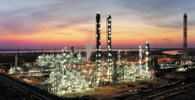 Germany-based BASF, the world's largest chemical manufacturer, acquired Swiss chemical maker Ciba last year in a $3.27 billion transaction.
Germany-based BASF, the world's largest chemical manufacturer, acquired Swiss chemical maker Ciba last year in a $3.27 billion transaction.
As part of this, BASF India has started the process to merge with Ciba India, both being stock exchange-listed entities here. Prasad Chandran, chairman and managing director of the Rs 4,000 crore (Rs 40 billion) BASF Group in India and also Head of South Asia, talks to PB Jayakumar on the merger and growth plans here. Excerpts:
How does Ciba's acquisition help BASF in India? What is the status of the merger process here?
The acquisition of Ciba's product portfolio and assets offer synergistic benefits and is a perfect strategic fit for us. As a result, BASF will open new routes to market and increase our presence in the plastics and coatings' chemicals business.
By combining the paper businesses, we will create a strong broad technology and service-oriented supplier of choice for customers. Our businesses complement each other in performance products, which includes paper, chemicals, coating effects and care chemicals.
We are in the process of finalising the organisational structures to better serve our customers in all the segments. Any overlap in the functional areas such as back-office service, warehousing, etc is also addressed and we expect to derive some synergy benefits.
The integration process is expected to be completed by April 2010. The appointed date for the merger is February 1, subject to approval of shareholders and the Bombay high court. After the requisite approvals, Ciba India Ltd, its cent percent subsidiary, Diamond Dye-Chem, and Ciba Research (India) Pvt Ltd will merge with BASF India Ltd.
What are the growth drivers for BASF in India and what are your plans?
At the moment, BASF is concentrating on consolidating our market position in existing business through local supplies and expansion of customer network in rapidly growing industries, integrating Ciba into BASF and ramping up our current production sites in Mangalore and Thane.
Depending on the market demand situation in India, the sites could be expanded very easily. We have identified India and China among our key focus geographies, and in the future we expect these two countries to contribute 20 per cent of our global turnover.
Where does India stand in the global business of BASF? How much of investment will come to India over the next two-three years?
BASF is in India for the past 63 years. BASF has grown both organically and through acquisitions in this market. The acquisition of Pushpa Polymers, the global acquisition of Ciba Holdings AG, acquiring the crop protection business of American Cynamid, divestment of the dyes business to Dystar and sale of the printing ink business, and the acquisition of Engelhard and the construction business from Degusa reflects our approach to the changing business environment in this market.
We are setting up a compounding plant at the Thane site for engineering plastics with a capacity of 9,000 tonnes per annum, with an investment of Rs 17.2 crore (Rs 172 million). Mechanical work has been completed and we are now running product qualification trials.
We are also exploring the possibility of de-bottlenecking of the facility in Mangalore for certain products. In the current environment, we are working towards cost containment. We will remain flexible depending on new ideas or projects coming up.
Has the chemical industry come out of the recent economic slowdown?
In the first half of 2008, most chemical companies were bullish about market demand and the prices for raw materials witnessed historic highs. Orders were booming across the US, Europe and Asia. However, since September 2008, prices for most commodity chemicals started declining sharply on a week-on-week basis.
Customers were incurring significant losses on imported raw materials and resorted to cutting production and reducing their inventory.
Since January 2009, there have been some positive signs in the India market, with orders picking up. We're hopeful that demand will pick up in coming months, as the outlook for end-use industries is showing improvement. In the past, the chemical industry has been growing at a compounded annual 8-9 per cent.
This is primarily because of the low per capita chemical consumption in India, as compared to developed countries. We expect the chemical industry to keep growing at the same rate in the mid-term. Polymers and speciality chemicals are expected to grow faster than the others during this period.
Despite a presence in India for over six decades, don't you think the growth for BASF ($68 billion worldwide) was on a slow track?
If you look at our business, we are manufacturers for manufacturers, offering customised chemistry solutions. Our growth in India is dependent on growth of manufacturing industries. We started (our own) manufacturing units in the country only in the past decade.
Many of BASF's innovations have a direct cost benefit for manufacturers in helping them reduce the number of manufacturing steps. Others are targeted at saving costs for the consumer over the life-cycle of the product.
For instance, BASF is supplying Tata Motors with products and engineering solutions for the Nano car that reduce emissions, enhance fuel efficiency and improve the car's overall aesthetic look.
For this, project experts from BASF's network worldwide, from Engineering Plastics, Coatings and Catalysts' divisions worked together for years to make catalytic converters for emission reduction. Tata Motors is using BASF's material for its plastic air intake manifold in the Nano.
The component is produced by Tata Visteon and uses BASF's Ultramid glass-fibre-reinforced engineering plastic. BASF also provided development support ranging from computer simulation studies in the design phase to component tests in the trial phase, carried out at BASF's engineering plastics' technical centres.
BASF Coatings has been approved to supply some colours for the Nano and, BASF Polyurethanes' PU system material fulfilled the technical specification of the seating foam for the Nano.